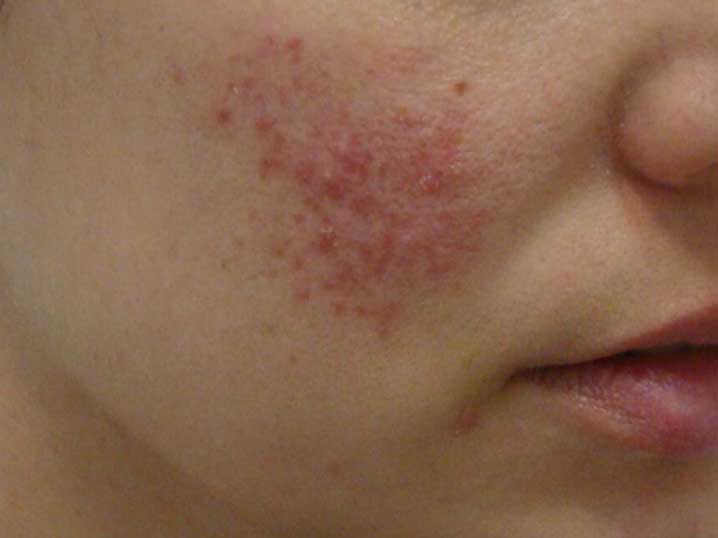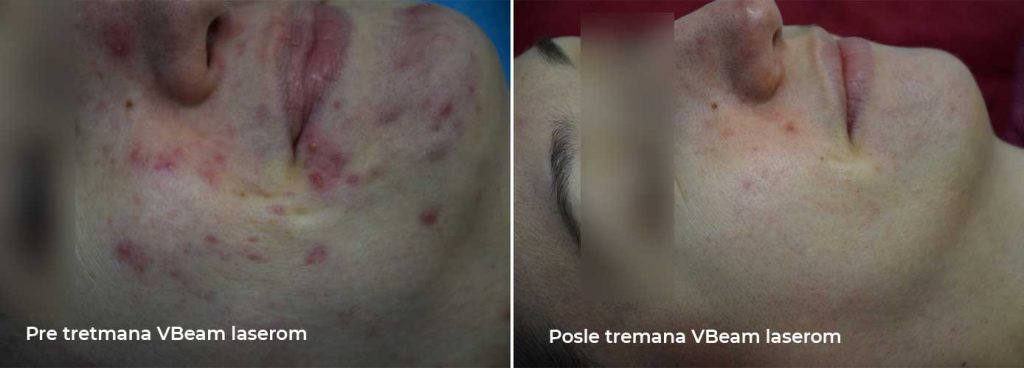What are the symptoms of rosacea?
Lesions affect cheeks, nose, chin and middle part of the forehead symmetrically. Blushing episodes often occur many years before the onset of the full clinical picture of rosacea. They are most pronounced when moving from warm to cold space, when consuming alcohol or very spicy food, as well as when exposed to physical activity and sun. Patients often complain of burning sensation, especially after applying special cosmetic preparations. Over time, enlarged blood vessels, small rash and pustules also appear. If not adequately treated, permanently enlarged blood vessels can develop. Men can develop the enlargement of the sebaceous glands and thickening of the subcutaneous tissue especially in the region of the nose. The cause of this condition is unknown, but it is assumed that rosacea can be triggered by solar radiation, alcohol, spicy foods, caffeine, heat, stress, hormonal changes, as well as Helicobacter pylori.
How the skin should be treated?
The skin should be washed with mild soap-free agents that don’t dry out the skin and are adapted to the sensitive skin. Hot water causes redness, so you should use cold or lukewarm. Also, makeup should be odourless, with sun protection factor.How various factors cause skin redness?
Different foods can trigger the appearance and exacerbation of redness in different people. In some individuals, hot drinks worsen the appearance of the face, and in some patients it is alcohol, especially red wine, coffee, as well as some spices. It hasn’t been proven that minerals and vitamins enriched diet has a significant effect on this condition. Most of the studies that have been conducted examined the effect of zinc, but they showed different results. While some of them showed significant improvement, others didn’t. Stress can, also, affect the facial skin, and be atrigger for rosacea. Physical activity greatly relieves stress, but people who are being treated for rosacea triggered by exercise should choose rooms with an adequate temperature that are well ventilated. Also, to avoid overheating, workouts at shorter intervals are recommended.Rosacea types
The first type is erythematotelangiectatic rosacea. It is characterized by frequent episodes of transient facial erythema (flushing) and nontransient, or persistent, erythema, as well as broken blood vessels. The second type is papulopustular rosacea. It is characterized by previously mentioned symptoms with the appearance of undefined pimples with or without purulent content. The third type is rhinophyma. It occurs more often in men than in women. Along with the aforementioned symptoms, the enlargement of the sebaceous glands is also present causing a cauliflower-like surface on the facial skin with a significant enlargement of the nose. The fourth type is ocular rosacea. It typically affects the eyes, clinically resembling conjunctivitis. It can contain all the previously listed symptoms accompanied by eye problems. This type of rosacea can be localized only on the eyes.Rosacea treatment
Rosacea can be very successfully kept under control, although it is difficult to cure. Treatment must be individual, resulting in imperceptible redness of the facial skin. When it comes to general measures, it is necessary to avoid factors that cause the expansion of blood vessels and worsen redness. Therapy can be topical, with preparations containing azelaic acid, tretinoin, metronidazole or ichthyol. It is also often necessary to introduce oral therapy, with antibiotics or isotretinoin. In our clinic, special creams and treatment with the latest Candela VBeam laser are successfully combined for the treatment of facial redness.Rosacea is a chronic inflammation of the facial skin, with transient or permanent redness and visible dilated capillaries. Rosacea is characterized by facial skin dryness and hypersensitivity as well as tinging, burning and tightening sensations. Sun protection and avoiding provoking factors such as exposure to heat, cold, alcohol, stress are the most important forms of rosacea prevention.
There are different types of therapy, however, the redness and dilated capillaries can only be removed by a laser.
VBeam laser, Pulsed Dye laser-PDL is the gold standard when it comes to treating redness and dilated capillaries on the face.
VBeam laser treatments are very effective and completely safe even for the most sensitive skin.
There is no long period of skin recovery after the treatment, which makes it the most popular treatment in the world currently.


How does the VBeam laser work?
Candela VBeam laser is the latest version of the Pulsed Dye laser, 20 times more powerful and 18 times faster than other PDL lasers. It emits yellow light at a wavelength of 595 nm, which is absorbed by oxyhemoglobin, a red pigment found in blood vessels, when it passes through the skin. In this way, selective closure, destruction of dilated capillaries and other vascular changes occur without damaging the surrounding tissue.
VBeam laser has a dynamic cooling device, which emits a stream of cryogen along with the laser beam and lowers the skin temperature thus preventing its damage.
Redness on the face is significantly alleviated after a single laser treatment, and the capillaries may disappear completely.
The most important effect is the reduction of patient’s subjective problems: the disappearance of burning, tingling and stinging sensations on the skin.
The treatment can be repeated after one month in order to achieve better and more lasting results.

What does a VBeam laser treatment look like?
VBeam laser treatment is simple and has no side effects. The laser can be used to treat the face, neck and décolletage areas. A slight tingling sensation is felt during the treatment. Redness which appears after the treatment subsides in about 2 days.
A slight swelling can sometimes occur which can be alleviated by icing the area.
With stronger pulse energy, better efficiency is achieved, but smaller areas of the skin can get a bluish discoloration which completely subsides in 7 days.
Makeup can be applied to the skin immediately after the treatment, and the use of SPF 50+ creams for sun protection is recommended for one month.
How many treatments are necessary?
3 to 4 treatments at intervals of 4 to 6 weeks are usually required to completely clear the redness. Maintenance treatments can be performed later, if necessary. Kasnije se po potrebi mogu raditi tretmani održavanja postignutog efekta.




